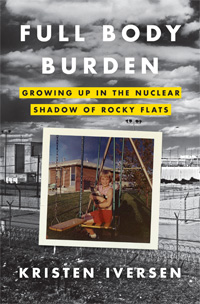The Cost of Silence
In her new memoir, Full Body Burden, Memphis writer Kristen Iversen recounts a childhood haunted by secrets
“My childhood has been shadowed by two enormous fears: my father’s alcoholism and Rocky Flats,” writes Kristen Iversen, director of the M.F.A. program in creative writing at the University of Memphis. With honesty and dignity, Iversen explains how her increasingly troubled father and ineffectual mother created a fragile home life that depended on silence and secrets—an atmosphere not unlike that of the mismanaged and deadly dangerous nuclear-weapons facility at Rocky Flats, located near their suburban Colorado home. “The body is an organ of memory, holding traces of all our experiences,” Iversen writes. “The land, too, carries the burden of all its changes. To truly see and understand a landscape is to see its depth as well as its smooth surfaces, its beauty and its scars.” In Full Body Burden, Iversen illuminates the beauty of her childhood memories, but she does not flinch from uncovering the damage simultaneously inflicted upon her and her family, upon the land, and ultimately upon us all.
 Between 1952 and 1989, the Rocky Flats Nuclear Weapons Plant, located outside the town of Arvada, Colorado, produced more than seventy thousand plutonium “triggers” designed to create a nuclear blast similar to the one released in Nagasaki on August 9, 1945. Each trigger, part of the U.S. Cold War arsenal, cost nearly four million dollars to make and contained “enough breathable particles of plutonium to kill every person on earth,” according to Iversen. In 1988, the Department of Energy released a study that named Rocky Flats “the most dangerous site in the United States, primarily due to hazardous waste in the groundwater and the large population [including Denver, Colorado] directly downwind and downstream.”
Between 1952 and 1989, the Rocky Flats Nuclear Weapons Plant, located outside the town of Arvada, Colorado, produced more than seventy thousand plutonium “triggers” designed to create a nuclear blast similar to the one released in Nagasaki on August 9, 1945. Each trigger, part of the U.S. Cold War arsenal, cost nearly four million dollars to make and contained “enough breathable particles of plutonium to kill every person on earth,” according to Iversen. In 1988, the Department of Energy released a study that named Rocky Flats “the most dangerous site in the United States, primarily due to hazardous waste in the groundwater and the large population [including Denver, Colorado] directly downwind and downstream.”
Among those living downwind and downstream of Rocky Flats during the 1960s and 1970s were Kristen Iversen and her family. Iversen’s father, a lawyer, and her mother, a homemaker, were Midwesterners of Danish and Norwegian descent. They chose a fresh start for their young family in Colorado because it was a land of “no parents, no farms, no heavy Lutheran traditions.” Kristen, her younger sisters, Karin and Karma, and their little brother, Kurt, grew up unfettered, often outdoors, and largely unsupervised, riding their horses through open fields and swimming in nearby lakes. They seemed to enjoy a perfect childhood. But eventually their father’s drinking problem—never discussed within the family—took a devastating toll. “Your father is going down the tubes” became their mother’s frequent refrain.
Also in trouble was nearby Rocky Flats. Built in 1951 at a cost of forty-five million dollars, the facility was protected by “an impenetrable wall of secrecy,” courtesy of the Atomic Energy Act of 1946, not to mention barbed wire, armed guards, and eventually, tanks. For decades, many in the local community did not even realize what was produced at Rocky Flats. They also did not know that the plant’s very location violated the regulations of the Atomic Energy Commission (AEC). The area’s chinook winds, coming down from the Rocky Mountains often in excess of one hundred miles per hour, blow across the dry and sparsely vegetated landscape directly toward densely populated areas, and the site’s watershed empties into nearby creeks, which feed into reservoirs that provide drinking water for local communities.
 Over the years, a pattern began to develop at Rocky Flats. Safety measures were compromised in the name of increased production, and hundreds of accidents occurred, including several potentially catastrophic fires that released dangerous contaminants into the environment, created millions of dollars’ worth of damage, and necessitated months or years of clean-up. Officials continually downplayed the health risks, and workers were denied access to their own medical records. Five thousand leaky barrels of toxic waste were improperly stored and then left unmonitored in the middle of a field for more than a decade. Iversen writes, “The problem with Rocky Flats is not just a smoking chimney or a hole in the dike. The weapons plant is like a bag filled with ultrafine sand—a bag filled with millions of glittering, radioactive specks too tiny to see—and the bag has been pricked with pins.”
Over the years, a pattern began to develop at Rocky Flats. Safety measures were compromised in the name of increased production, and hundreds of accidents occurred, including several potentially catastrophic fires that released dangerous contaminants into the environment, created millions of dollars’ worth of damage, and necessitated months or years of clean-up. Officials continually downplayed the health risks, and workers were denied access to their own medical records. Five thousand leaky barrels of toxic waste were improperly stored and then left unmonitored in the middle of a field for more than a decade. Iversen writes, “The problem with Rocky Flats is not just a smoking chimney or a hole in the dike. The weapons plant is like a bag filled with ultrafine sand—a bag filled with millions of glittering, radioactive specks too tiny to see—and the bag has been pricked with pins.”
Plutonium was discovered by Marie Curie in 1899, but the danger it poses to human health was not immediately understood. In 1945 the AEC declared the “plutonium tolerance level” for plant workers to be one microgram, or one millionth of a gram; later, that level was labeled a “potentially lethal dose.” Invisible to the naked eye, airborne plutonium dust is easily ingested or inhaled. Once inside the body, it settles within the tissues, and its effects are permanent: it continues to emit radiation throughout the host’s lifetime, although it may take many years for illness to be detected. The amount of plutonium unaccounted for by the time production at Rocky Flats ended was an astounding three thousand pounds—two and one-half tons. Some of it remained in the facility’s complicated maze of duct work and filters, but most is believed to have been leaked into the air, water, and soil surrounding the facility.
Eventually, people began to pay attention. Protests were staged by notable activists of the time, including the Pentagon Papers’ Daniel Ellsberg and poet Allen Ginsberg. Testing revealed high levels of plutonium, uranium, americium, tritium, and strontium in local livestock. Air-monitoring stations detected “higher levels of [plutonium] than any others in the western hemisphere.” Workers at Rocky Flats and local citizens were found to have higher-than-average cancer rates, yet community leaders were initially reluctant to accept the truth. “Plutonium was supposed to be a savior, to save us from the enemy,” Iversen explains. “It wasn’t supposed to leak and burn and blow away, seep down into the water table and fly up into the sky. It was supposed to pay attention to borders and fences and property lines. It was supposed to know the good guys from the bad guys.”
Iversen painstakingly identifies the scientific experts of the time and translates their alarming statistics. She vividly describes several accidents at Rocky Flats over the years and the heroic yet inept responses of those working without sufficient training or equipment under the most dangerous conditions imaginable. She provides an extensive timeline that highlights each important event at the facility over the course of decades.
But Full Body Burden is more than a history of the mismanagement and decline of an American nuclear-weapons facility during the Cold War or even of that facility’s poisoning of nearby communities. It’s also a history of the decline of a family. The intimately personal passages of the book, seamlessly interwoven with the cold, hard facts of Rocky Flats, speak most eloquently and most movingly about what it’s like to watch the unfolding of excruciatingly painful events over which one has no control: the unimaginable toll taken by the disease of alcoholism, the sudden death of a young person, the disintegration of a marriage, the persistent fear of illness and death, the failure of hope, the loss of the most tender, innocent part of oneself.
“Body burden” is defined as “the amount of radioactive material present in a human body, which acts as an internal and ongoing source of radiation.” By exposing to the world the burden that she and others now carry—both physical and emotional—Iversen reminds readers that the tragedy of Rocky Flats is not only the terrible effects of the radiation itself but also the knowledge that deliberate harm was done, can never be undone, and should never be forgotten. “The cost of silence and the secrets it contains is high, but you don’t learn the price until later,” Iversen writes. “Secrets depend upon the smooth facade of silence, on the calm flat water that hides the darker depths.” In Full Body Burden, Iversen plumbs the darker depths of pain and loss that inevitably result when our choices—whether those of a parent or a government—are controlled by greed and fear.


